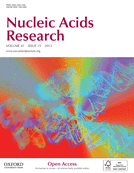 RNA-based therapeutic approaches using splice-switching oligonucleotides have been successfully applied to rescue dystrophin in Duchenne muscular dystrophy (DMD) preclinical models and are currently being evaluated in DMD patients. Although the modular structure of dystrophin protein tolerates internal deletions, many mutations that affect non-dispensable domains of the protein require further strategies. Among these, trans-splicing technology is particularly attractive, as it allows the replacement of any mutated exon by its normal version as well as introducing missing exons or correcting duplication mutations. In this study, the authors have applied such a strategy in vitro by using co-transfection of pre-trans-splicing molecule (PTM) constructs along with a reporter minigene containing part of the dystrophin gene harbouring the stop-codon mutation found in the mdx mouse model of DMD. Optimisation of the different functional domains of the PTMs allowed achieving accurate and efficient trans-splicing of up to 30% of the transcript encoded by the co-transfected minigene. Optimised parameters included mRNA stabilization, choice of splice site sequence, inclusion of exon splice enhancers and artificial intronic sequence. Intramuscular delivery of adeno-associated virus vectors expressing PTMs allowed detectable levels of dystrophin in mdx and mdx4Cv, illustrating that a given PTM can be suitable for a variety of mutations.
RNA-based therapeutic approaches using splice-switching oligonucleotides have been successfully applied to rescue dystrophin in Duchenne muscular dystrophy (DMD) preclinical models and are currently being evaluated in DMD patients. Although the modular structure of dystrophin protein tolerates internal deletions, many mutations that affect non-dispensable domains of the protein require further strategies. Among these, trans-splicing technology is particularly attractive, as it allows the replacement of any mutated exon by its normal version as well as introducing missing exons or correcting duplication mutations. In this study, the authors have applied such a strategy in vitro by using co-transfection of pre-trans-splicing molecule (PTM) constructs along with a reporter minigene containing part of the dystrophin gene harbouring the stop-codon mutation found in the mdx mouse model of DMD. Optimisation of the different functional domains of the PTMs allowed achieving accurate and efficient trans-splicing of up to 30% of the transcript encoded by the co-transfected minigene. Optimised parameters included mRNA stabilization, choice of splice site sequence, inclusion of exon splice enhancers and artificial intronic sequence. Intramuscular delivery of adeno-associated virus vectors expressing PTMs allowed detectable levels of dystrophin in mdx and mdx4Cv, illustrating that a given PTM can be suitable for a variety of mutations.
